Giuseppe Conte
| Giuseppe Conte | |
|---|---|
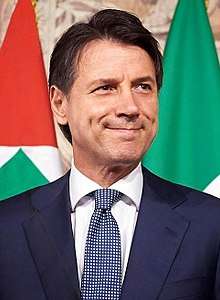 | |
| 58th Prime Minister of Italy | |
|
Assumed office 1 June 2018 | |
| President | Sergio Mattarella |
| Deputy |
Luigi Di Maio Matteo Salvini |
| Preceded by | Paolo Gentiloni |
| Personal details | |
| Born |
8 August 1964 Volturara Appula, Italy |
| Political party | Independent[1] |
| Spouse(s) | Valentina Fico (div.)[2] |
| Domestic partner | Olivia Paladino[3] |
| Children | 1 |
| Residence | Palazzo Chigi |
| Alma mater | Sapienza University |
| Occupation | |
| Website | Official website |
| ||
|---|---|---|
Prime Minister (2018–present)
|
||
Giuseppe Conte (Italian pronunciation: [dʒuˈzɛppe ˈkonte]; born 8 August 1964) is an Italian jurist and politician serving as the 58th and current Prime Minister of Italy since 1 June 2018.[4]
A professor of private law, Conte was first proposed on 21 May 2018 for the role of Prime Minister as the head of a coalition government between the Five Star Movement and the League,[5] but he relinquished his role when Paolo Savona, who was picked for Minister of Economy and Finance, was vetoed by President Sergio Mattarella.[6] On 31 May, the two parties reached an agreement, proposing Giovanni Tria as Minister of Economy and Finances, and Conte was called to take the oath of office on the following day.[7]
Conte's cabinet is considered by many newspapers such as The New York Times and la Repubblica as the first populist government in Western Europe.[8][9][10] Moreover, he was the first person to assume the premiership without prior government or administrative service since Silvio Berlusconi in 1994 and the first Prime Minister from Southern Italy since the Christian Democrat Ciriaco De Mita in 1989.[11][12]
Early life and career
Conte was born on 8 August 1964 into a middle class family at Volturara Appula, near Foggia.[13][14] His father Nicola was a public employee in the local municipality while his mother Lillina Roberti was an elementary school teacher.[15][16]
After his family moved to San Giovanni Rotondo, Conte attended the Classical Lyceum "Pietro Giannone" in nearby San Marco in Lamis and then studied Law at the La Sapienza University of Rome, where he graduated in 1988 with distinction.[17][18][19] For short terms, Conte studied abroad. In 1992, he moved to the United States to study at Yale Law School and Duquesne University and at the International Culture Institute in Vienna in 1993. He later researched or lectured at Sorbonne University in 2000, Girton College, Cambridge in 2001 and New York University in 2008.[20][21]
He started his academic career during the 1990s, when he taught at Roma Tre University, at LUMSA University of Rome, at the University of Malta and at the University of Sassari.[18] Conte is currently professor of private law at the University of Florence and at LUISS of Rome.[22][23] He sits on the board of trustees of John Cabot University in Rome.[24]
On 18 September 2013, he was elected by the Chamber of Deputies as a member of the Bureau of Administrative Justice, the self-governing body of administrative magistrates.[25]
Government formation
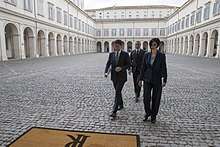
In February 2018, Conte was selected by Luigi Di Maio, leader of the Five Star Movement (M5S), as the future possible Minister of Public Administration in his cabinet following the 2018 general election.[26] However, the election resulted in a hung parliament,[27] with the M5S that became the party with the largest number of votes and of parliamentary seats while the centre-right coalition, led by Matteo Salvini's League and other right-wing parties, emerged with a plurality of seats in the Chamber of Deputies and in the Senate. The centre-left coalition led by former Prime Minister Matteo Renzi came third.[28]
On 9 May, after weeks of political deadlock and the failure of various attempts of forming cabinets both between M5S–Centre-right and M5S–Democratic Party, Di Maio and Salvini responded to President Sergio Mattarella's ultimatum to appoint a neutral technocratic caretaker government by officially requesting that he allow them 24 more hours to achieve a governing agreement between their two parties.[29][30] Later that same day in the evening, Silvio Berlusconi publicly announced Forza Italia would not support a M5S–League government on a vote of confidence, but he would still maintain the centre-right alliance nonetheless, thus opening the doors to a possible majority government between the two parties.[31]
On 13 May, M5S and League reached an agreement in principle on a government program, likely clearing the way for the formation of a governing coalition between the two parties, but could not find an agreement regarding the members of a government cabinet, most importantly the Prime Minister. M5S and League leaders met with President Sergio Mattarella on 14 May to guide the formation of a new government.[32] On their meeting with President Mattarella, both parties asked for an additional week of negotiations to agree on a detailed government program and a Prime Minister to lead the joint government. Both M5S and the League announced their intention to ask their respective members to vote on the government agreement by the weekend.[33][34]
On 21 May, Conte was proposed by Di Maio and Salvini for the role of Prime Minister in the 2018 Italian government,[35][36][37] despite reports in the Italian press suggesting that President Mattarella still had significant reservations about the direction of the new government.[38] On 23 May, Conte was invited to the Quirinal Palace to receive the presidential mandate to form a new cabinet.[39][40] In the traditional statement after the appointment, Conte said that he would be the "defense lawyer of Italian people".[41]
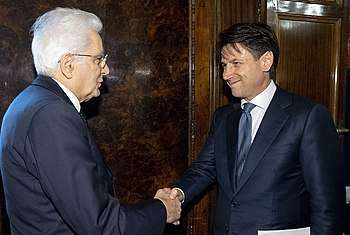
On 27 May, Conte renounced his office due to contrasts between Salvini and President Mattarella. Salvini proposed the university professor Paolo Savona as Minister of Economy and Finances, but Mattarella strongly opposed him, considering Savona too Eurosceptic and anti-German.[42] In his speech after Conte's resignation, Mattarella declared that the two parties wanted to bring Italy out of the Eurozone and as the guarantor of Italian Constitution and country's interest and stability he could not allow this.[43][44]
On the following day, Mattarella gave Carlo Cottarelli, a former director of the International Monetary Fund, the task of forming a new government.[45] On 28 May, the Democratic Party (PD) announced that it would abstain from voting the confidence to Cottarelli while the M5S and the center-right parties Forza Italia (FI), Brothers of Italy (FdI) and the League announced their vote against.[46][47]
Cottarelli was expected to submit his list of ministers for approval to President Mattarella on 29 May. On 29 May and 30 May, he held only informal consultations with the President, waiting for the formation of a "political government".[48][49] Meanwhile, Salvini and Di Maio announced their willingness to restart the negotiations to form a political government and Giorgia Meloni, leader of FdI, gave her support to the initiative.[48][49][50] On May 31, M5S and the League declared of having reached an agreement about forming a new government without Paolo Savona as Finance Minister (he would become Minister of European affairs instead) and with Conte at its head.[51][52]
Prime Minister of Italy

On 1 June 2018, despite having no political experience, Conte officially succeeded the Democrat Paolo Gentiloni at the head of the Italian government, swearing as new Prime Minister in the afternoon.[53] His cabinet was predominantly composed by members of the M5S and the League, but also by prominent independent technocrats like the Minister of Foreign Affairs Enzo Moavero Milanesi, who previously served as Minister of European Affairs in the government of Mario Monti, the university professor Giovanni Tria as Minister of Economy and Finances and economist Paolo Savona, who served in the cabinet of Carlo Azeglio Ciampi in the 1990s and currently known for his Eurosceptic views, that would become the new Minister of European Affairs.[54][55]
Both parties' leaders Salvini and Di Maio were appointed Deputy Prime Ministers. While the first became Minister of the Interior, with the main aim of drastically reducing the number of illegal immigrants, the latter served as Minister of Economic Development, Labour and Social Policies to introduce the universal basic income.[56][57]
The coalition of the two populist parties which Conte led was also known as Government of Change,[58] thanks to a document that summarized the electoral programmes of the two parties, which was called "Contract for the Government of Change".[59][60]
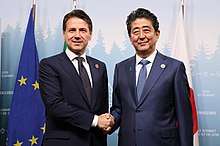
During his speech before the investiture vote in the Italian Senate on 5 June, Conte announced his willingness to reduce illegal immigration and increase the contrast to human traffickers and smugglers. He also advocated a fight against political corruption, the introduction of a law which regulates the conflict of interests, a new bill which expands the right of self-defense, a taxes reduction and a drastic cut to politics's costs, thanks to the annuities' abolition.[61][62][63] Conte also proposed to lift off the international sanctions against Russia.[64]
The Senate approved the confidence vote with 171 votes in favor and 117 against, with 25 abstentions.[65] The cabinet was supported by M5S, Lega, two senators from Associative Movement Italians Abroad (MAIE) and two independents while the Democratic Party (PD), Forza Italia (FI), Free and Equal (LeU) and other small leftist parties voted against it. The far-right Brothers of Italy (FdI) and other ten independent senators abstained.[66] On the following day, he received 350 votes in favor out of 630 in the Chamber of Deputies, 236 votes against and 35 abstained.[67] As in the Senate, PD, FI and LeU voted against the government while FdI abstained. Besides M5S and League, Conte received two votes from independent deputies and one vote from Vittorio Sgarbi, a notable and controversial member of Forza Italia who has always heavily criticised the M5S, but decided to support the cabinet in respect of Salvini and with the hope that a M5S government could lead toward their failure.[68][69]
Economic policies

One of Conte's main proposals was the scheduled reform of the Italian tax system, mainly promoted by the League and characterized by the introduction of flat taxes for businesses and individuals, with a no-tax area for low-income households and some small corrections to keep some degree of tax progression as required by the Italian Constitution.[70][71] The government stressed that they will find the funds to implement it through the so-called "fiscal peace", that is a condonation.[72] However, many important economists and newspapers like Il Sole 24 Ore denounced that the condonation could not finance all the new tax system based on flat tax.[73]
Conte also announced more severe punishments for tax dodgers, which are a major problem in Italy.[74]
Immigration
When Conte became Prime Minister in 2018, he acted quickly to deliver on promises to his anti-immigrant base through strict controls on immigration to Italy. Since 2013, Italy absorbed over 700,000 African migrants arriving by boat from Libya.[75][76] During his premiership, Conte and his Interior Minister Matteo Salvini promoted stricter policies regarding immigration and public security.[77]
After Conte's approval on 10 June 2018, Salvini announced the closure of Italian ports, stating: "Everyone in Europe is doing their own business, now Italy is also raising its head. Let's stop the business of illegal immigration".[78] The vessel Aquarius, which is operated jointly by Médecins Sans Frontières and SOS Méditerranée and carried more than 600 migrants, was refused a port of disembarkation by the Italian authorities despite having been told to rescue the migrants by the same co-ordination centre. The Italian authority told the vessel to ask Malta to provide a disembarkation port, but Malta has also refused.[79] On the following day, the new Spanish Prime Minister Pedro Sánchez accepted the disputed migrant ship.[80] Conte accused French President Emmanuel Macron of hypocrisy after Macron said Italy was acting "irresponsibly" by refusing entry to migrants and suggested it had violated international maritime law.[81]
Foreign policy

Since the beginning of his term as Prime Minister, Conte's foreign policy was characterized by a strong approach to Russia as he advocated the deletion of international sanctions, which according to him damage the Italian economy.[82] He also considered Russia a strategic partner in the fight against Islamic terrorism.[83] However, Conte stressed that under his leadership Italy will remain an active member of NATO and a close ally of the United States.[84]
On 8 and 9 June, Conte participated in his first G7 summit in Canada, hosted by Prime Minister Justin Trudeau.[85] During the summit, he was the only leader to back President Donald Trump and his proposal to readmit Russia into the G7.[86] However, he later assumed a more pro-European view, shared by the other five leaders, condemning Trump tariffs on steel and aluminium exported by the European Union.[87] On the following day, Conte was thanked for his positions on Russia and his populist stance by President Trump, who invited him to the White House.[88] After a few days, Trump praised Conte, describing him as a "really great" leader and "very strong on immigration".[89] On 28 June, Conte participated in his first European Council meeting and blocked a joint EU trade and defense statement criticizing Trump's tariff policy.[90]
Political views
During an interview in 2018, Conte said he used to vote for the left before approaching the M5S during the early 2010s. He also added that today "the ideological schemes of the 20th century are no longer adequate to represent the current political system" and it should be "more important and correct to evaluate the work of a political force on how it is positioned on the respect of fundamental rights and freedoms".[91]
In his inaugural speech at the Senate on 5 June 2018,[92][93] in response to attacks on government political forces accused of being populist and anti-establishment, Conte replied that "if populism is the attitude of the ruling class to listen to the people's needs [...] and if anti-establishment means aiming at introducing a new system able to remove old privileges and encrusted power, well these political forces deserve both these epithets".[94][95][96]
He also opposed the "hypertrophy of Italian laws", advocating the repeal of useless laws and supported a simplification of bureaucracy.[97] Conte strongly opposed the school reform legislation promoted by Matteo Renzi's government in 2015, known as "The Good School", which he said must be completely revised.[98]
Conte is an observant Roman Catholic and a votary to Padre Pio of Pietrelcina.[99]
Controversies
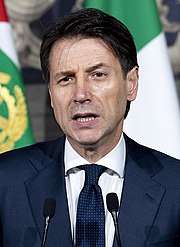
On 21 May 2018, when the name of Conte was proposed to President Mattarella as candidate for Prime Minister,[36] The New York Times, questioning his summer stays at New York University (NYU) listed in his official curriculum vitae,[20] published an article asserting that a NYU spokeswoman did not find the name of Conte in university "records as either a student or faculty member".[100][101] Similar doubts arose concerning his study period in France at Sorbonne University. [102]
The following day, the Associated Press reported in an article published also by The New York Times that the NYU spokeswoman added that "while Mr. Conte had no official status at NYU, he was granted permission to conduct research in the NYU law library" during the period listed in his official curriculum vitae.[20][103] Similarly, the Duquesne University of Pittsburgh and the University of Malta found no record of him in their archives,[104] although it was confirmed that Conte held lectures at the old university building in Valletta, Malta for the Foundation for International Studies.[105] Yale University, contacted by another newspaper, also confirmed that he studied there for three months.[106]
Moreover, Conte stated in his CV that he had worked on his legal studies at the Kultur Institute in Vienna, Austria. However, this is a Language School and not a Law Faculty.[107]
Authored books
- Il volontariato. Libertà dei privati e mediazione giuridica dello Stato. Rome: Pioda. 1996.
- Matrimonio civile e teoria della simulazione. Rome: Pioda. 1996.
- La simulazione del matrimonio nella teoria del negozio giuridico. Padua: CEDAM. 1999.
- Le regole della solidarità. Iniziative non profit dei privati e mediazione dei pubblici poteri. Rome: Pioda. 2001.
- Il danno non patrimoniale. Milan: Giuffrè. 2018.
- La formazione del contratto. Milan: Giuffrè. 2018.
- L'impresa responsabile. Milan: Giuffrè. 2018.
References
- ↑ "Il premier tecnico di un governo politico". Cosa dicono i giornali". AGI – Agenzia Giornalistica Italia. Retrieved 2 June 2018.
- ↑ "Valentina, chi è l'ex moglie di Giuseppe Conte". Retrieved 2 June 2018.
- ↑ "Giuseppe Conte, la sua fidanzata? Olivia Paladino: bellissima e biondissima, è la figlia del proprietario dell'Hotel Plaza".
- ↑ "Raggiunto l'accordo per un governo M5S-Lega con Conte premier" (in Italian).
- ↑ "Novice to lead Italian populist cabinet". 23 May 2018. Retrieved 2 June 2018 – via bbc.com.
- ↑ "Italian president faces impeachment call". 28 May 2018. Retrieved 2 June 2018 – via www.bbc.com.
- ↑ "Giuramento governo: alle 16 Conte e i ministri al Quirinale". Retrieved 2 June 2018.
- ↑ ""Italia primo governo populista in Europa occidentale"". adnkronos.com. Retrieved 2 June 2018.
- ↑ "Giuseppe Conte: Italy's next PM to form western Europe's first populist government". Retrieved 2 June 2018.
- ↑ "Opinion – The Populists Take Rome". 24 May 2018. Retrieved 2 June 2018 – via NYTimes.com.
- ↑ "Da Renzi a Conte: ecco chi sono i presidenti del Consiglio non eletti in parlamento". 25 May 2018. Retrieved 2 June 2018.
- ↑ "Da De Mita a Conte, l'incarico torna a sud di Roma dopo trent'anni". Retrieved 2 June 2018.
- ↑ "Giuseppe Conte, legalità e semplificazione le sue parole d'ordine – Politica". 20 May 2018. Retrieved 2 June 2018.
- ↑ "Governo: Conte, il 'bambino prodigio' legatissimo a Volturara – Puglia". 21 May 2018. Retrieved 2 June 2018.
- ↑ Borrillo, Michelangelo. "Chi è Giuseppe Conte, il premier che «viene dalla periferia» – Video". Retrieved 2 June 2018.
- ↑ "Studioso e riservato, e molto devoto a Padre Pio". Il racconto del miglior amico del "premier" Conte". 21 May 2018. Retrieved 2 June 2018.
- ↑ "Governo, a Volturara e a San Giovanni Rotondo nelle città che fanno il tifo per Conte". 21 May 2018. Retrieved 2 June 2018.
- 1 2 Cortellessa, Carlo Michele. "Conte Giuseppe". Retrieved 2 June 2018.
- ↑ "Il candidato alla Presidenza del Governo è uno di noi..." SanMarcoinLamis.eu (in Italian). 23 May 2018. Retrieved 31 May 2018.
- 1 2 3 "Curricula dei candidati alle elezioni a componente del Consiglio di Presidenza della Giustizia Amministrativa" (PDF). Camera dei deputati (in Italian). 17 September 2013. Retrieved 5 June 2018.
- ↑ "Giuseppe Conte, avvocato civilista e "sburocratizzatore". Ecco chi è il premier indicato da M5S e Lega a Mattarella". The Huffington Post. 20 May 2018. Retrieved 2 June 2018.
- ↑ "Giuseppe Conte".
- ↑ "Diritto Privato – LUISS Guido Carli". docenti.luiss.it. Retrieved 2 June 2018.
- ↑ "John Cabot Trustee Giuseppe Conte Named New Italian Prime Minister". news.johncabot.edu. 24 May 2018. Retrieved 2 June 2018.
- ↑ "Eletti i componenti dei Consigli di presidenza della Giustizia amministrativa, della Corte dei conti, della Giustizia tributaria". Camera dei deputati. Retrieved 2 June 2018.
- ↑ "Ecco tutti i "ministri" del governo del Movimento 5 Stelle". Retrieved 2 June 2018.
- ↑ Sala, Alessandro. "Elezioni 2018: M5S primo partito, nel centrodestra la Lega supera FI".
- ↑ "Elezioni politiche: vincono M5s e Lega. Crollo del Partito democratico. Centrodestra prima coalizione. Il Carroccio sorpassa Forza Italia". 4 March 2018.
- ↑ "Mattarella postpones choice of caretaker premier amid new coalition govt talks". Adnkronos. 9 May 2018. Retrieved 8 June 2018.
- ↑ "Italy's populist parties given 24 hours to avert fresh elections". Financial Times. 9 May 2018. Retrieved 9 May 2018.
- ↑ "Governo M5S-Lega, Berlusconi: nessun veto all'intesa ma no alla fiducia". La Repubblica (in Italian). GEDI Gruppo Editoriale. 9 May 2018. Retrieved 9 May 2018.
- ↑ "Italy's populist 5 Star, League parties reach deal on government program". MarketWatch. 13 May 2018.
- ↑ "Giuseppe Conte, un giurista per governo del cambiamento. Di Maio: Premier sarà un amico del popolo". RAInews (in Italian). 21 May 2018.
- ↑ "M5s e Lega da Mattarella. Di Maio: "Conte premier di governo politico". Salvini: "Interesse italiani al centro" [M5s & Mattarella of Lega, Di Maio said 'Conte will be prime minister of a political government]. La Repubblica (in Italian). GEDI Gruppo Editoriale. 21 May 2018. Retrieved 24 May 2018.
- ↑ "Chi è Giuseppe Conte, scelto da Luigi Di Maio per la possibile squadra di governo". formiche.net (in Italian). 28 February 2018.
- 1 2 "Italy populist government pact: Candidate for prime minister named". BBC News. 21 May 2018. Retrieved 24 May 2018.
- ↑ "Italian president in talks as populist parties put forward novice for PM". The Guardian.
- ↑ "Italy's Populists Move Closer to Power, With Little-Known Pick for Prime Minister". The New York Times.
- ↑ News, ABC. "The Latest: Premier-designate confirms Italy's place in EU". Retrieved 2 June 2018.
- ↑ "Di Battista all'attacco di Mattarella: "Non si opponga agli italiani". La lunga giornata del Colle". 23 May 2018. Retrieved 2 June 2018.
- ↑ "Governo, Conte incaricato da Mattarella: "Sarò l'avvocato difensore degli italiani". Retrieved 2 June 2018.
- ↑ "Governo, il giorno della rinuncia di Conte. Ecco come è fallita la trattativa su Savona". 27 May 2018. Retrieved 2 June 2018.
- ↑ "L'ora più buia di Mattarella: la scelta obbligata di difendere l'interesse nazionale dopo il no dei partiti alla soluzione Giorgetti per l'Economia". 27 May 2018. Retrieved 2 June 2018.
- ↑ "Governo, firme e tweet di solidarietà a Mattarella. Ma spuntano anche minacce di morte". 27 May 2018. Retrieved 2 June 2018.
- ↑ "Cottarelli accetta l'incarico: "Senza fiducia il Paese al voto dopo agosto". Repubblica.it (in Italian). 28 May 2018. Retrieved 28 May 2018.
- ↑ "Berlusconi: "No alla fiducia e centrodestra unito al voto". Ma Salvini: "Alleanza con Fi? Ci penserò". Repubblica.it (in Italian). 28 May 2018. Retrieved 29 May 2018.
- ↑ "Pd, Martina: "Fiducia a Cottarelli". Renzi: "Salviamo il Paese". E i dem: manifestazione nazionale a Roma il 1° giugno". Repubblica.it (in Italian). 28 May 2018. Retrieved 29 May 2018.
- 1 2 "Incontro informale in corso tra Cottarelli e MattarellaI tre scenari possibili". Corriere della Sera (in Ityalian). Retrieved 30 May 2018.
- 1 2 "Governo, Cottarelli vede Mattarella. Ora al lavoro alla Camera. Riparte la trattativa giallo-verde". Repubblica.it (in Italian). 2018-05-30. Retrieved 2018-05-30.
- ↑ "Di Maio: "Impeachment non più sul tavolo". E si riapre l'ipotesi di un governo Lega-M5s". Repubblica.it (in Italian). 2018-05-29. Retrieved 3 May 2018.
- ↑ "Governo, Conte accetta l'incarico e presenta la lista: 18 ministri, 5 le donne. Tria all'Economia". 31 May 2018. Retrieved 2 June 2018.
- ↑ "Nasce il governo Conte. Presentata a Mattarella la lista dei ministri. Di Maio e Salvini vicepremier". RaiNews (in Italian). 1 June 2018. Retrieved 1 June 2018.
- ↑ "L'annuncio del Quirinale: "Conte accetta l'incarico, domani si giura alle 16". Retrieved 2 June 2018.
- ↑ "Nasce il governo Conte, Di Maio e Salvini vice. Ecco i ministri dell'esecutivo M5s-Lega". 31 May 2018. Retrieved 2 June 2018.
- ↑ "Nuovi ministri: la lista completa dell'esecutivo Lega-M5S". Retrieved 2 June 2018.
- ↑ "Governo Conte, chi sono i ministri: da Di Maio e Salvini (con i fedelissimi) agli "istituzionali" come Moavero. Poi il prof di educazione fisica e il generale che indagò su Terra dei Fuochi – Il Fatto Quotidiano". 1 June 2018. Retrieved 2 June 2018.
- ↑ "Nasce il governo Lega-M5S: Salvini e Di Maio vice che pesano più del premier". Retrieved 2 June 2018.
- ↑ "Il premier incaricato Conte: "Governo del cambiamento"". Retrieved 2 June 2018.
- ↑ "Contratto di governo Lega–M5S: ecco il testo"
- ↑ "'Government of change': Euroskeptic coalition's choice for Italian PM officially approved". Retrieved 2 June 2018.
- ↑ "Governo alla prova. Conte: "Basta business dei migranti, daspo per corrotti e corruttori".
- ↑ "Conte: tasse eque, salario minimo e giù debito con la crescita".
- ↑ "Comunicazioni del Presidente del Consiglio dei ministri. Senato della Repubblica – seduta del 5 giugno 2018. Resoconto stenografico" (PDF). Full text of his speech.
- ↑ "Italy breaks with European allies and voices support for Russia after populist party takes power".
- ↑ "The Latest: Italy's populist govt wins 1st confidence vote".
- ↑ "Governo, 171 sì per la fiducia, Conte: euro non in discussione. Salvini: no aumento Iva".
- ↑ "Camera, approvata la fiducia. Conte: "Tratteremo con l'Ue sul nostro debito". Delrio (Pd): "Studi la Carta, non sia un pupazzo".
- ↑ "Governo, lo strappo di Sgarbi: "Penso malissimo di Di Maio. Ma voto sì: Salvini realizzerà il programma di centrodestra".
- ↑ "Governo, Sgarbi show alla Camera: "Dove c'è il disordine io prospero. Voterò la fiducia per assistere al vostro declino".
- ↑ "Flat tax, cos'è e come funziona: due aliquote al 15 e 20%, premiati i redditi più alti".
- ↑ "Flat tax: cos'è come funziona per famiglie e imprese e quali vantaggi?".
- ↑ "La pace fiscale pentaleghista conferma che l'Italia è una repubblica fondata sul condono".
- ↑ "Flat tax, dalla pace fiscale ai bonus alla no tax area: perché non tornano i conti".
- ↑ "Jail for tax dodgers, bans for corrupt - Conte".
- ↑ "What will Italy's new government mean for migrants?". The Local. 21 May 2018.
- ↑ "African migrants fear for future as Italy struggles with surge in arrivals". Reuters. 18 July 2017.
- ↑ "Migranti: Conte, grazie Salvini, Italia non piu' sola; il premier da Macron e Merkel".
- ↑ "Migranti, l'Italia sfida Malta. Salvini: chiudiamo i porti".
- ↑ "More than 600 migrants running out of food as Italy shuts port to rescue ship".
- ↑ "Spain to accept disputed migrant ship Aquarius".
- ↑ "Italian foreign ministry summons French ambassador as tensions mount over port closures to refugee rescue boats". The Independent. 13 June 2018.
- ↑ "Italian Prime Minister plans to end sanctions against Russia".
- ↑ "Conte: appartenenza alla Nato ma apriremo alla Russia".
- ↑ "Conte: restiamo nella Nato e con Usa ma via sanzioni alla Russia".
- ↑ "G7, il primo incontro del premier Conte con gli altri leader".
- ↑ "Italy's new PM backs Trump on re-admitting Russia into the G7".
- ↑ G7, Trump isolato. Merkel e Macron riallinenao Conte. Il presidente francese: "Valori comuni Ue"
- ↑ "Trump: Italy's populist prime minister to visit White House".
- ↑ "Trump: «Il primo ministro italiano Conte è fantastico. È severo sull'immigrazione e in questo momento paga»".
- ↑ https://www.reuters.com/article/us-eu-summit-conte/italy-blocks-joint-text-on-trade-defense-at-eu-summit-idUSKBN1JO2UF
- ↑ "Giuseppe Conte, ecco chi è il presidente del consiglio del governo Lega-M5s". Il Fatto Quotidiano. 31 May 2018. Retrieved 2 June 2018.
- ↑ "Il discorso di Conte in Senato, la versione integrale" (PDF). la Repubblica (in Italian). Retrieved 7 June 2018.
- ↑ Dichiarazioni programmatiche - L'intervento del Presidente Conte al Senato (official video) (in Italian). Italy: Governo Italiano - Presidenza del Consiglio dei Ministri. 5 June 2018. Retrieved 7 June 2018.
- ↑ "Italy's New Populist Government Articulates Vision, but Few Specifics".
- ↑ "Highlights: Italian Prime Minister Giuseppe Conte's inaugural speech". Reuters. 5 June 2018. Retrieved 7 June 2018.
- ↑ Conte: "Noi populisti? Ascoltiamo la gente. il Giornale (video) (in Italian). Italy. 5 June 2018. Retrieved 7 June 2018.
- ↑ "Conte, giurista anti-burocrazia con un passato a sinistra". Retrieved 2 June 2018.
- ↑ "Giuseppe Conte: rivedere, pressoché integralmente, la riforma della cattiva scuola".
- ↑ "Devoto di Padre Pio, secchione e di sinistra. Il "Financial Times" lo stronca: un novellino". il Giornale. Retrieved 2 June 2018.
- ↑ Horowitz, Jason (21 May 2018). "Italy's Populists Offer Giuseppe Conte for Prime Minister; N.Y.U. Claim in Question". The New York Times. Retrieved 4 June 2018.
- ↑ "Giuseppe Conte, Nyt: "Nel cv studi alla New York University che non risultano all'ateneo". Accademici: "Visiting scholar non sono registrati"". Il Fatto Quotidiano (in Italian). 22 May 2018. Retrieved 2 June 2018.
- ↑ https://www.theguardian.com/world/2018/may/22/italy-giuseppe-conte-cv-new-york-university
- ↑ "The Latest: Italy PM pick had 'no official status' at NYU". AP News. Associated Press. 22 May 2018. Retrieved 5 June 2018.
"The Latest: Italy PM pick had 'no official status' at NYU". The New York Times. Associated Press. 22 May 2018. Retrieved 5 June 2018. - ↑ Lorenzo De Cicco; Francesca Pierantozzi; Flavio Pompetti (22 May 2018). "Conte, dopo New York anche le università di Malta e Pittsburgh: «Non ha mai studiato o insegnato ufficialmente qui»". Il Messaggero (in Italian). Retrieved 5 June 2018.
- ↑ "Italian prime minister candidate says he lectured in Malta - but the University has no record of him". Times of Malta. 22 May 2018. Retrieved 4 June 2018.
- ↑ Sarcina, Giuseppe (25 May 2018). "Conte e il curriculum, Yale conferma: «Visiting scholar per tre mesi»". Corriere della Sera. Retrieved 2 June 2018.
- ↑ https://www.theguardian.com/world/2018/may/22/italy-giuseppe-conte-cv-new-york-university
External links
- University of Florence personal page (including CV and publication list in English)
- Giuseppe Conte publications indexed by the Scopus bibliographic database. (subscription required)
| Political offices | ||
|---|---|---|
| Preceded by Paolo Gentiloni |
Prime Minister of Italy 2018–present |
Incumbent |
| Order of precedence | ||
| Preceded by Roberto Fico as President of the Chamber of Deputies |
Order of precedence of Italy as Prime Minister |
Succeeded by Giorgio Lattanzi as President of the Constitutional Court |
.jpg)
.svg.png)

